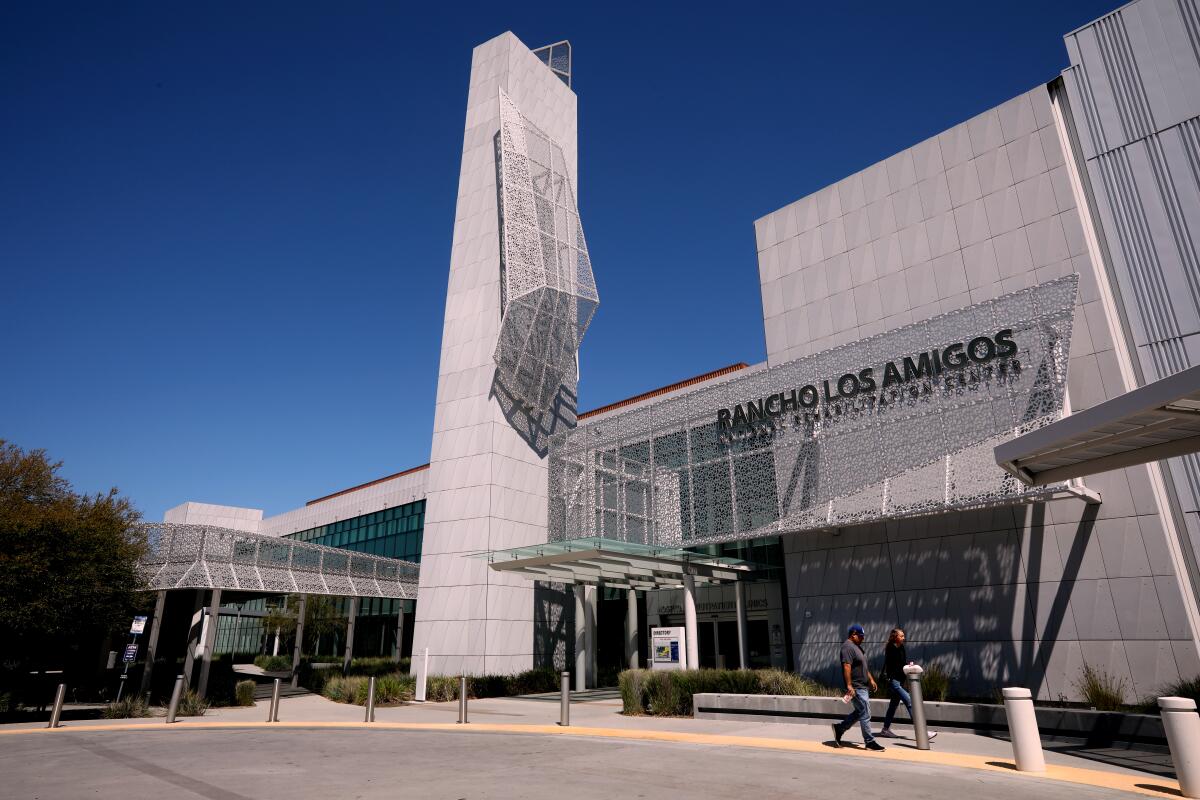This anesthesiologist is L.A. County’s highest paid employee. He works 94 hours a week

- Share via
The joke around the hospital is that Dr. Sebo Amirkhanian Namagerdy does not leave Rancho Los Amigos, a premier rehabilitation facility run by Los Angeles County.
His Mercedes is always in the parking lot. A former nurse found him to be such a permanent fixture at the Downey hospital that she compared him to “a piece of the material.” Doctors at other county-run facilities have heard of the guy who’s the “one-man-show” of his intensive care unit.
“He’s basically living there,” said a Rancho doctor, one of four current and former hospital employees who spoke with The Times on the condition of anonymity to discuss a colleague. “I see him in the mornings with a toothbrush and a towel around his neck.”
It’s a lucrative second home. Namagerdy, an anesthesiologist in the hospital’s ICU, earned $1.26 million in 2023, according to salary data made public last month.
He was the highest paid of the county’s more than 100,000 employees — for the fifth year in a row.
In 2023, he made about $450,000 more than any other Rancho doctor or any other county anesthesiologist. He made about as much as his boss, his boss’ boss and his boss’ boss’ boss combined. (The head of Rancho Los Amigos made a little under $400,000, the head of the county’s health department made about $600,000 and a county supervisor made about $280,000.)
Sign up for This Evening's Big Stories
Catch up on the day with the 7 biggest L.A. Times stories in your inbox every weekday evening.
You may occasionally receive promotional content from the Los Angeles Times.
Namagerdy’s sky-high salary stems from a heavy workload amid a crushing shortage of doctors in parts of the county health system. A Times review of salary data found that Namagerdy worked hours far beyond what the county’s own policies allow — and beyond what experts consider safe.
Namagerdy, who graduated from the Iran University of Medical Sciences in 2000, was paid for working an average of 94 hours per week in 2023, according to salary records obtained by The Times. In both 2022 and 2021, he was paid for an average of more than 101 hours a week.
If he worked five days a week, that would average out to 19 hours a day last year and about 20 hours a day in the two prior years.
“As you probably know, there are 168 hours in a week,” said patient safety expert David Bates, professor of health policy and management at the Harvard School of Public Health. “No one can can work that much and do it safely.”
It’s not Namagerdy’s only gig. Certified in both critical care and anesthesiology, he also works part-time as a critical care doctor at UCI-Health Fountain Valley, a community hospital in Orange County. A hospital spokesperson said Namagerdy was working an average of six 12-hour shifts per month as of last fall.
Namagerdy declined to speak with a reporter, saying the inquiries amounted to harassment before hanging up the phone. The chief executive of Rancho Los Amigos, Aries Limbaga, did not respond to requests for comment. The L.A. County Department of Health Services, which oversees the hospital, noted that the hours for ICU physicians such as Namagerdy include time resting between caring for patients and that these doctors work 90 hours some weeks.
“Patient safety is our top priority,” the department said. “There were no patient safety concerns in the case of this doctor.”
It’s a time commitment that raises eyebrows even in a sector famous for punishing hours. Several county physicians said the hours went far beyond what they would want their own doctor to work, even with breaks for sleep. Medical residents, who log grueling hours as they train to be doctors, are limited to 80 hours a week on average by the national group that accredits residency programs.
Christopher Landrigan, director of the Sleep and Patient Safety Program at Boston’s Brigham and Women’s Hospital, said extreme shifts can increase medical errors and drain a doctor’s empathy, of particular concern in the case of ICU specialists, who treat some of the sickest patients.
Subscribers get early access to this story
We’re offering L.A. Times subscribers first access to our best journalism. Thank you for your support.
“There’s a responsibility for the hospital, too. The science is crystal clear: working those kinds of hours in a week is dangerous,” said Landrigan. “Frankly, just from a common sense standpoint, if something were to go wrong, it’s a hard pattern to defend.”
Known around the hospital as Dr. Sebo, the middle-aged anesthesiologist has developed a reputation as a workhorse, albeit one with a penchant for inappropriate remarks, according to current and former colleagues. He could be abrasive with patients’ families but left their loved ones much healthier than when he found them. He was accessible to staff but had little patience for what he viewed as stupidity. Some colleagues found him energetic and generous, others demeaning.
Some county doctors, who as government employees can see all their colleagues’ salaries online, have wondered how a fellow physician could so drastically outearn them year after year. Several suggested that anyone taking home that amount must be fudging their time cards, though no evidence has emerged to back up that theory.
A county attorney rejected a public record request for Namagerdy’s time cards, stating that “whether one particular physician (among hundreds within DHS) committed time card violations … is not a public interest that outweighs” potential privacy issues.
Doctors inside Rancho suggest there’s a more likely culprit: a failure by the hospital to adequately staff the ICU, leaving physicians to work extraordinary hours to fill the gaps.
“Salaries are not competitive, they can’t recruit — and they found someone who is willing to basically live in the hospital,” said a Rancho doctor, who was granted anonymity to talk about his colleague. “I can tell you: This is not a sustainable long-term strategy.”
Until 2022, only two physicians — Namagerdy and Amarish Pradhan — worked full-time in Rancho’s round-the-clock ICU, which would have required each doctor to work 12 hours every day of the week, according to two Rancho doctors interviewed by The Times.
Pradhan didn’t put in nearly as many hours as his colleague. But last year, according to The Times’ salary calculations, Pradhan was paid for working 71 hours a week on average, netting him $736,000 and making him one of the top 20 highest-paid county employees. He earned about $650,000 in 2022.
Some county doctors say it’s a microcosm of larger staffing issues playing out across the county’s hospitals, which are a safety net for hundreds of thousands of poor and uninsured patients. The Union of American Physicians and Dentists, which represents county doctors, nearly went on strike over the winter holidays, arguing that meager benefits had caused hospitals to hemorrhage staff. Unable to replace them, some doctors say, hospital leaders are leaning too heavily on a handful of staffers to put in extreme hours.
“It’s a sign of mismanagement, honestly,” said Chris Ige, a regional administrator for the union, pointing to coverage gaps in the county’s jails and clinics that force some doctors to do extreme amounts of overtime — if nothing close to Namagerdy’s hours.
The Times first reached out to the county health department in late 2022 with questions about Namagerdy’s salary. At the time, the hospital said his top-charting pay stemmed from his work during the pandemic, when Rancho’s ICU took overflow patients from the county’s three sister hospitals.
“The appropriately paid additional work hours provided by Dr. Sebo was essential for the care of critically ill patients during the worst health crisis in a century,” the department said. “Indeed, nearly 100% of his time was allocated to direct patient care without the assistance of resident physicians.”
The health department did not answer a series of questions from The Times last month about Namagerdy’s hours and the staffing of the ICU. Two doctors at Rancho say a third full-time doctor was hired to work in the ICU in 2022, though Namagerdy’s hours only dipped moderately the next year.
Last year, Edna Yarashevich, a nurse in Rancho’s ICU, sued both the county and Namagerdy, accusing the anesthesiologist in her lawsuit of making vulgar sexual references at work, including discussing anal sex, comparing the removal of a catheter to sex (“you go in and out”) and flipping her off before inserting his middle finger in a patient’s anus. He also told a nurse that there was a woman he “cannot stand looking at” and that his “wife’s bush looks better than” the woman’s face, according to the lawsuit.
Yarashevich alleged in the lawsuit that she complained to multiple supervisors, including Pradhan, who told her that Namagerdy’s behavior “has been going on for years but that it is now getting out of control.” Matthew Matern, whose firm represents Yarashevich, declined to comment.
The health department said it had previously launched an investigation into the allegations and takes all accusations of staff misconduct “extremely seriously.” Lawyers representing Namagerdy and the county in the lawsuit did not respond to a request for comment.
For over a century, Rancho Los Amigos has been a catchall for the county’s poorest patients.
The rehabilitation facility takes patients recuperating from debilitating injuries and illnesses. The eight-bed ICU takes critically ill patients the other county hospitals don’t have room for.
In 2017, the nationally renowned facility had a problem: Not enough doctors wanted to work there.
Supervisor Janice Hahn, whose district includes the hospital, told her colleagues during a discussion about a new residency program that she wanted to see less “dependence” on outside contract physicians at Rancho — an expensive practice that other county hospitals had weaned themselves off of, according to county documents.
But Rancho struggled to find replacements for the contract physicians— particularly in the ICU, according to records from the time.
So the hospital turned to two doctors already there.
That year, the county put Namagerdy and Pradhan on something called the “physician registry,” records show.
The registry, developed in 2012, is a list of physicians who can work in short-staffed areas on an hourly, as-needed basis beyond their regular jobs, according to county records.
It’s a good deal for all involved. Doctors like it because they get paid 1.35 times their hourly rate for these “relief” shifts — better than standard overtime where they only get their hourly rate. The union, which helped create the registry, likes it because it helps prevent the best doctors from leaving for higher-paying private hospitals. And the health department likes it because it’s cheaper and more reliable than staffing an undermanned hospital with outside contract physicians.
Of the more than 900 doctors employed with the health department as of 2023, fewer than 70 have been part of the registry at some point in their careers, according to county records.
Physicians on the registry — known as “relief physicians” — say the system is designed to entice a county employee to work extra shifts when the need arises. For example, a doctor at Olive View occasionally treats inmates at the short-staffed jails. A doctor at Harbor-UCLA used to pick up random shifts at their regular job.
But at Rancho Los Amigos, Namagerdy has worked what amounts to an additional full-time job in the ICU — despite county policies barring the practice.
Relief physicians can work a maximum of 24 hours a week outside of their standard hours, according to the county’s agreements with the union. But hospital officials appear to have allowed both Rancho ICU doctors to blow past that limit — Namagerdy in particular.
Last year, Namagerdy earned $467,000 for his regular 40-hour work week and nearly $800,000 for hours put in as a registry physician. That amounts to an average of 54 additional hours per week.
In 2022, he earned an extra $906,000 for working an average of 61 additional hours per week on top of his regular salary. In 2021, he earned an extra $929,000 for working an average of 63 additional hours.
“He would do 24-hour shifts, like three or four days in a row,” said a Rancho doctor. “In our profession, like I’ve seen people do stuff like that, but not at this age and this long. I have never seen someone do this before.”
The Times calculated Namagerdy’s hours by dividing the money he received for relief work by his hourly rate. Namagerdy received $284 an hour for relief work, while Pradhan received $223, according to the county payroll division.
Pradhan earned roughly $357,000 last year for his work as a relief physician, according to records, amounting to an additional 31 hours per week on average. That’s on top of the roughly $380,000 he was paid for his regular 40-hour week.
No other doctor on the relief registry earned more than $470,000 last year for relief work and their regular job combined.
The county health department did not respond to questions about why the 24-hour cap was not followed at Rancho’s ICU but said doctors typically work as relief physicians to help “meet unmet demand.”
The county added that Namagerdy’s status as a relief physician was “under review.”
More to Read
Sign up for This Evening's Big Stories
Catch up on the day with the 7 biggest L.A. Times stories in your inbox every weekday evening.
You may occasionally receive promotional content from the Los Angeles Times.











